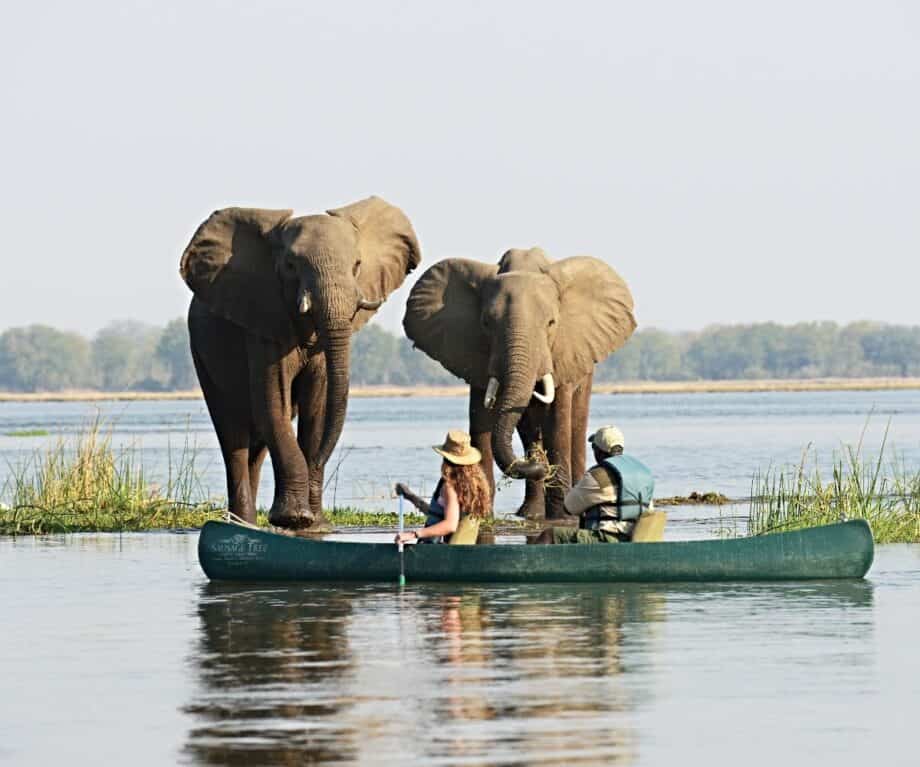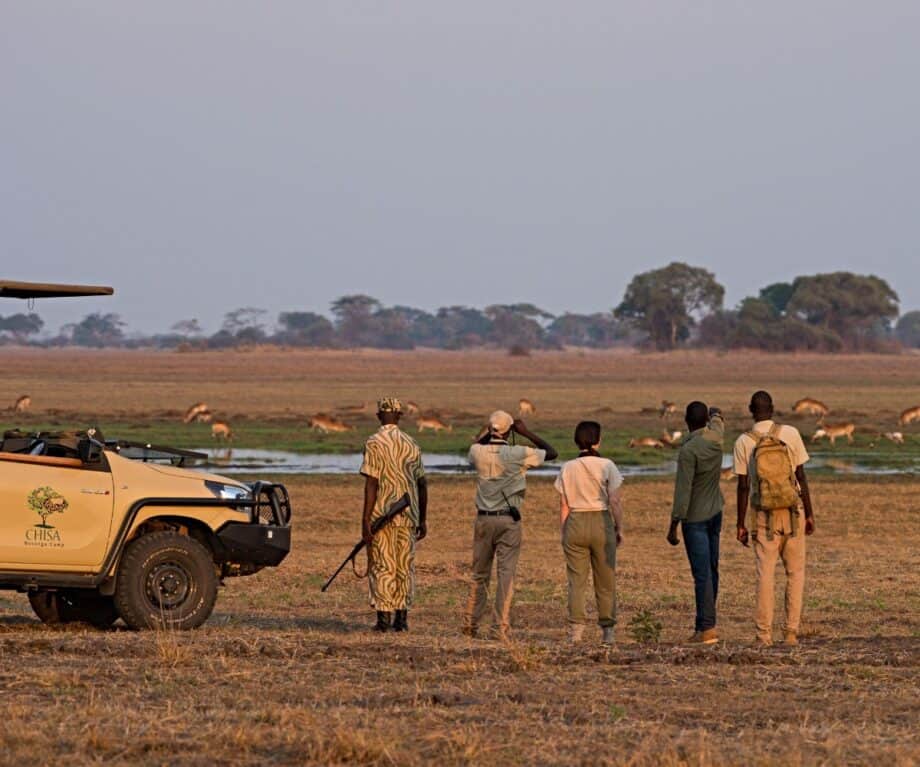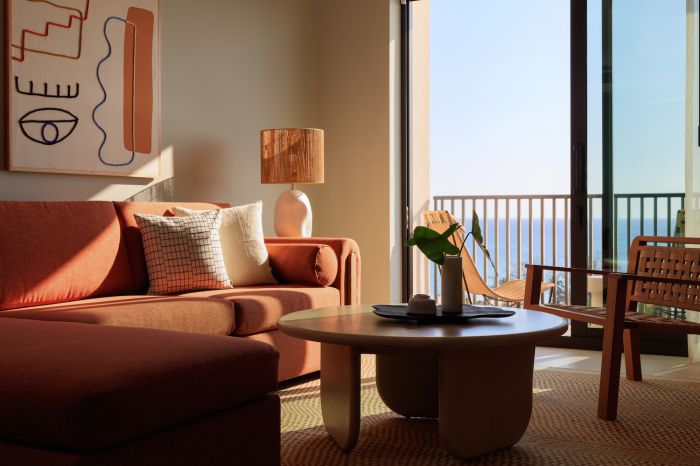Zambia has been my home for more than 30 years now and one of the things I’ve always loved most about the country is its wilderness, its wildlife and its amazing safari experiences.
Zambia arrived relatively slowly to the safari scene, overshadowed for many years by its neighbours. Despite having some of the best reserves on the continent, the country is not nearly as well known or as popular as its safari rivals in Southern and East Africa. With its pristine landscapes, diverse wildlife and exceptional conservation efforts, Zambia is one of Africa’s best kept safari secrets, and while not as high-profile as Kenya, , or , those in the know will tell you that this is one of Africa’s best safari spots, and one that’s not plagued by the hordes of tourists that invade other wildlife destinations.
Birthplace of the walking safari and home of the thundering Victoria Falls, Zambia is the place to be if you want to see swamp-dwelling tree-climbing lions, the planet’s greatest mammal migration, the continent’s second-largest wildebeest migration, several endemic species not found anywhere else and of course, a whole lot more. Whether you’re looking for the Big Five or just seeking the unspoiled African wilderness, Zambia has it all. Let’s explore five of the country’s top safari destinations.


Lower Zambezi National Park – For game drives, fishing and canoeing
The Lower Zambezi National Park is one of Africa’s greatest wildernesses. 4,092km² of unspoilt nature. With no paved roads, it’s rare to encounter another safari vehicle, and nighttime here is all about sitting out by the fire, under a sky full of stars.
The Zambezi, Africa’s fourth longest river, forms the boundary of the Lower Zambezi National Park. The area is an incredible wildlife sanctuary – herds of elephants and buffalos, lions, leopards and wild dogs, and over 400 different bird species. Whilst the diversity of animals is not as great as some parks (there are no giraffe, wildebeest, cheetah or rhino here) the beauty of the park lies in its wildness and the opportunities to get right up close to the wildlife.

Most of the wildlife is concentrated along the river, so a great way to experience the park is to board a boat, or drift silently past the riverbank in a canoe – you’ll see plenty of hippos peeking curiously above the water’s surface, and look out for the magnificent carmine bee-eaters who nest in the riverbanks from September to November. The river is also home to the coveted tiger fish – highly prized by serious sport fishermen.


Where to stay
is the epitome of bush chic, set in a stunning location along the Zambezi River right in the heart of the Lower Zambezi National Park. The guides are friendly and knowledgeable, the rooms are well designed, opening onto private plunge pools that overlook the river, and the cocktails are so good you may never want to leave!


South Luangwa National Park – For game drives
The 9,050km² South Luangwa National Park is renowned as one of Africa’s greatest wildlife destinations, with 60 animal species and over 450 different species of bird. Often referred to as ‘The Valley of Leopards’, the main predators here are leopard, lion, spotted hyena and wild dog – with the leopard population being amongst the densest in the world. Expect to see large herds of elephants, sometimes up to 70 strong. South Luangwa is also home to the endemic Thornicroft’s giraffe and Cookson’s wildebeest, and the near-endemic Crawshay’s zebra.
The best way to see South Luangwa’s wildlife is on a morning or afternoon game drive from your lodge. Expect early wakeups as most morning drives set off at around 6am. You’ll return to camp for a middle of the day siesta, and then head out again in the afternoon – the animals are more active at these cooler times of day. South Luangwa is where, in the 1960s, walking safaris first began, the brainchild of conservationist and guide, Norman Carr, and they’re a terrific way to view wildlife, big and small.

Where to stay
is a small, eco-friendly bush camp overlooking the Luangwa River in one of the park’s most untouched areas with excellent year round game viewing.

North Luangwa National Park – For walking safaris
The remote 4,636km² North Luangwa National Park is synonymous with walking safaris. The beauty of this park is the opportunity to experience Africa as it once was; wild and untouched. No game drives are permitted in the majority of the park and access is primarily by walking safaris. You’ll leave the 4×4 game-drive vehicle at camp and set out on foot with your guide and an armed park ranger, to walk among elephants, antelope, zebra and even the occasional predator, always maintaining a safe distance from the magnificent wildlife. In addition to strong populations of buffalo and elephants, there’s a number of black rhinos, making it the only Big Five park in Zambia. North Luangwa is a specialist safari destination, only recommended for seasoned safari-goers who are used to roughing it in the bush.

North Luangwa is one of three national parks in the Luangwa Valley, the others being South Luangwa and Luambe. Between the North and the South parks, on the eastern bank of the Luangwa River, is Luambe National Park. It’s small, covering only 250 km², and is usually only visited when travelling the rugged route between north and south parks by road and is the only accommodation option.

Where to stay
operate two camps that specialise in guided walking safaris. For the more adventurous and Community Camps, run by non-profit North Luangwa Conservation, offer self-catering, and for the intrepid, there’s the , a self-drive camping route.


Kafue National Park – For wildlife diversity
At 22,400 km² Kafue National Park represents 36% of Zambia’s National Parks land, and when combined with the surrounding 45,400 km² of Game Management Area, the resulting wildlife area of 68,000 km² represents a staggering 9% of Zambia’s total landmass. This is Zambia’s oldest and largest National Park and one of the continent’s wildest. A land without fences and with few roads, but with an extraordinary array of wildlife, Kafue is named for the river, the lifeblood of the park, that dissects it, almost north to south, running for more than 250km.
Whilst Kafue doesn’t have the huge herds of game that can be found in other parks, what it lacks in density it more than makes up for in diversity. There are at least 161 species of mammal, 6 cat species, and 22 species of antelope (Kafue boasts the highest antelope diversity of any African park). The park is also home to approximately 500 species of birds.


The Busanga swamps, with their adjacent flood plains, in the far northwest of the park, are a highlight of Kafue. Much of this northern sector is permanently waterlogged, but in the dry season (May to November) the water recedes, leaving vast expanses of lush grazing, irresistible to an array of wildlife, particularly large herds of red lechwe and puku.

Where to stay
in the northern part of the park is small, smart and innovative, with four tree-house nests that are comfortable and stylish with a touch of luxury.

Kasanka National Park – For bats and birds
Kasanka National Park is one of Zambia’s smallest national parks, but one of its hidden treasures and with an incredible 480 bird species and 114 mammals, there is a lot for you to see.
Kasanka is best known as home to the annual migration of Straw-Coloured Fruit Bats – the largest bat migration in the world and in fact, the world’s largest mammal migration. From October to December each year, about 10 million bats descend on a tiny patch of forest in the park. Migrating from thousands of miles away, some from as far away as West Africa. The migration is one of the natural world’s best-kept secrets – even scientists don’t know exactly where the bats come from, or where they go when they leave the park.


Beyond the bats, Kasanka gives you excellent opportunities to see and photograph one of Africa’s rarer antelopes, the shy, secretive and semi-aquatic sitatunga – the park is home to more than 500 of them, making it Africa’s densest and most visible population of Sitatunga! The elusive Blue monkey and the little-known Kinda baboon also both call Kasanka home and it’s unlikely you’ll encounter either of these species anywhere else in Southern Africa.

Where to stay
The non-profit Kasanka Trust have two basic lodges, , and a seasonal self-catering tented camp.


Liuwa Plain National Park – Wildebeest migration
The 3,369km² Liuwa Plains National Park in remote far west Zambia was once the traditional hunting ground of the Litunga (King) of the Lozi people. Liuwa Plain is home to the second largest wildebeest migration in Africa and yet it’s hardly known. Each year in November, with the start of the rainy season, massive herds of blue wildebeest, 45,000 strong, migrate to Liuwa Plains, often mingling with zebras along the way. An incredible sight to witness.


Other unusual antelope found here include oribi, red lechwe, steenbok, duiker, tsessebe and roan, and predators include wild dogs, lions and hyena. The birdlife is abundant and the dramatic lightning and storms at the start of the rains, make for spectacular views and fantastic photography opportunities.
Non-Profit African Parks is involved in managing Liuwa and has reintroduced lions, wild dogs, eland and buffalo, as well as working to protect the park.

In March or April, depending on the rainfall, visitors can experience the historic and epic Kuomboka festival, where the King and his subjects move to higher grounds, travelling in a large black and white striped boat along the river.

Where to stay
is the only permanent camp in Liuwa Plain National Park, it has six stylish, open-front safari tents that are the epitome of luxury. Non-profit African Parks have five in Liuwa Plain, four with basic facilities (flushing toilets, hot showers and solar lights), and one without. They also have Sibika Camp, four reed mat rooms on raised platforms and some self-catering facilities.

Mosi-oa-Tunya National Park
Zambia is famous for the Victoria Falls, the greatest curtain of falling water on the planet, one of the Seven Natural Wonders of the World and a natural border between Zambia and Zimbabwe. On the Zambian side, you can walk the paths directly opposite the Falls and cross the precarious Knife-Edge Bridge, for spectacular views of the eastern cataract and up the main gorge. There are also plenty of adventure activities to do here, from white water rafting, to microlight and helicopter flights.


The traditional name for Victoria Falls is Mosi-oa-Tunya, appropriately meaning ‘The Smoke that Thunders’. Mosi-oa-Tunya is also the name of Zambia’s smallest national park and the only one in the country with white rhinos. There are walks and drives in this 23.4 km²park, which is easily accessible from Livingstone. The park is home to giraffe, zebra, buffalo, many of Zambia’s different antelope species and plenty of elephants too. One of the best reasons to visit though, is the white rhinos and booking a guided walk in the park will give you an almost guaranteed chance of an up-close sighting. This little sanctuary is free from predators, making walking here safe. A visit to Mosi-oa-Tunya National Park is a great activity for those who’d like a taste of safari but don’t have time to travel further afield.

Where to stay
Beautiful is located on the banks of the Zambezi River, just 20 minutes upstream of the Victoria Falls.

8. Zambia’s Other National Parks
Of Zambia’s other National Parks, Luambe, Lukusuzi, West Lunga, Sioma Ngwezi, and Nyika Plateau have wildlife, but are relatively undeveloped in terms of infrastructure and accommodation. Isangano, Lavushi Manda, Lusenga Plain and Mweru Wantipa have little management, very few facilities, very limited wildlife populations and are only worth a visit if you are very intrepid or a super keen birder. Lusaka National Park, just outside the capital, opened in 2015, is the country’s newest park and is home to the Game Rangers International .

As a safari destination Zambia is one of Africa’s best-kept secrets. An amazing, game-rich, unspoilt destination. A safari in Zambia will give you a taste of the real Africa – wild and untamed.
Did you enjoy this article?
Receive similar content direct to your inbox.
Please enable JavaScript in your browser to submit the form




